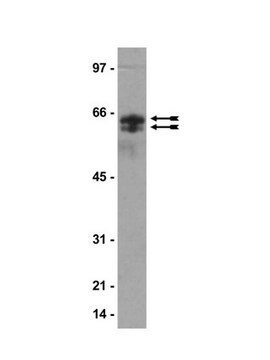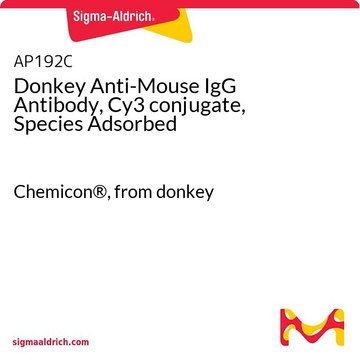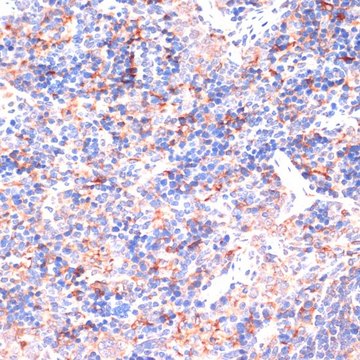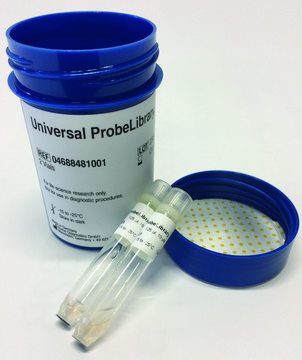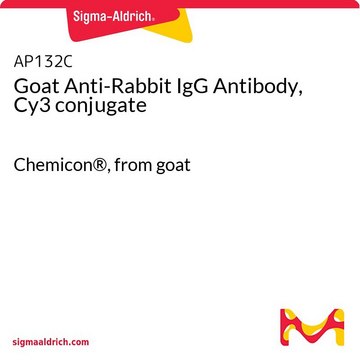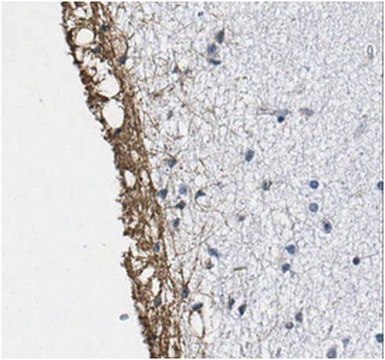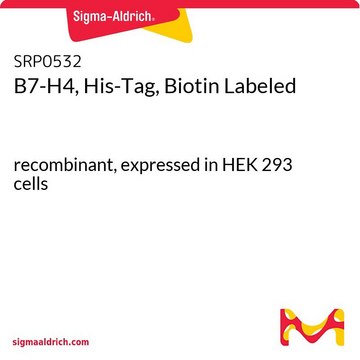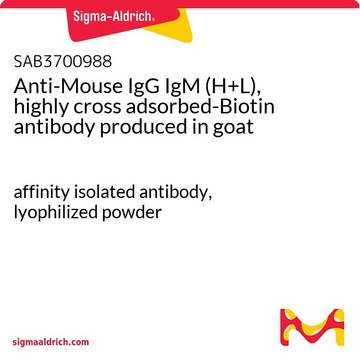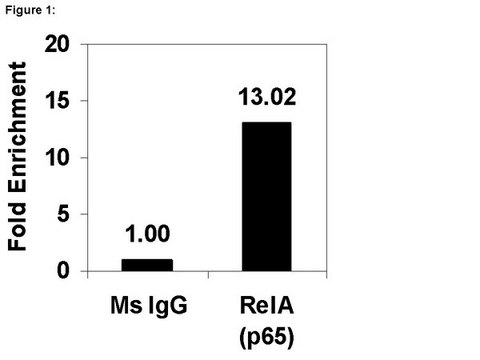AP200C
Goat Anti-Mouse light chain Antibody, Cy3 conjugate
Chemicon®, from goat
Sign Into View Organizational & Contract Pricing
All Photos(1)
About This Item
UNSPSC Code:
12352203
eCl@ss:
32160702
NACRES:
NA.46
Recommended Products
biological source
goat
Quality Level
conjugate
CY3 conjugate
antibody form
affinity purified immunoglobulin
antibody product type
secondary antibodies
clone
polyclonal
species reactivity
mouse
manufacturer/tradename
Chemicon®
technique(s)
ELISA: suitable
western blot: suitable
isotype
IgG
shipped in
wet ice
target post-translational modification
unmodified
General description
Antibody molecules typically comprise two immunoglobulin light chains covalently bound to a pair of heavy chains. Immunoglobulin light chains occur in two types, designated by the Greek letters kappa and lambda. Kappa and gamma light chains are approximately 250 amino acids in length with an average mass of about 25 kDa. The ratio of kappa to lambda found in the immunoglobulin population varies by species.
Specificity
Minimal cross-reaction with bovine, goat, horse, human, rabbit, rat, and sheep.
The antibody reacts strongly with native primary antibodies primarily with kappa light chains. It is not suitable for detecting lambda light chains. The antibody does not react with the heavy chain of mouse IgG. The antibody has been tested by ELISA and adsorbed to ensure minimal cross-reaction with bovine, goat, horse, human, rabbit, rat, and sheep immunoglobulins.
Immunogen
Epitope: Kappa light chain
Prepared from purified mouse IgG light chain.
Application
Suggested dilutions:
Western Blotting: 1:100 -1:800 of the 1 mg/mL stock
ELISA: 1:100 -1:800 of the 1 mg/mL stock
Optimal working dilutions must be determined by the end user.
Western Blotting: 1:100 -1:800 of the 1 mg/mL stock
ELISA: 1:100 -1:800 of the 1 mg/mL stock
Optimal working dilutions must be determined by the end user.
Research Category
Secondary & Control Antibodies
Secondary & Control Antibodies
Research Sub Category
Fragment Specific Secondary Antibodies
Fragment Specific Secondary Antibodies
This Goat anti-Mouse light chain Antibody, Cy3 conjugate is validated for use in ELISA, WB for the detection of Mouse light chain.
Target description
25 kDa
Physical form
ImmunoAffinity Purified
Lyophilized powder from a solution with 0.01M Sodium Phosphate, 0.25M NaCl, pH 7.6, 0.05% Sodium Azide. 15 mg/mL BSA as stabilizer. Purified by immunoaffinity chromatography.
Storage and Stability
Maintain lyophilized product at 2°-8°C for up to 12 months. After reconstitution the product is stable for six weeks at 2°-8°C in the dark as an undiluted liquid. Reconstitute vial with of distilled water (addition of 0.5 ml water will yield a final concentration of 1 mg/mL). For extended storage after reconstitution, add an equal volume of glycerol to make a final concentration of 50% glycerol followed by storage at -20°C in undiluted aliquots for up to 12 months. Please note the concentration of protein (and buffer salts) will decrease to one-half of the original after the addition of glycerol. Avoid repeated freeze thaw cycles. Keep away from light.
Legal Information
CHEMICON is a registered trademark of Merck KGaA, Darmstadt, Germany
Disclaimer
Unless otherwise stated in our catalog or other company documentation accompanying the product(s), our products are intended for research use only and are not to be used for any other purpose, which includes but is not limited to, unauthorized commercial uses, in vitro diagnostic uses, ex vivo or in vivo therapeutic uses or any type of consumption or application to humans or animals.
Not finding the right product?
Try our Product Selector Tool.
Hazard Statements
Precautionary Statements
Hazard Classifications
Aquatic Chronic 3
Storage Class Code
11 - Combustible Solids
WGK
WGK 3
Certificates of Analysis (COA)
Search for Certificates of Analysis (COA) by entering the products Lot/Batch Number. Lot and Batch Numbers can be found on a product’s label following the words ‘Lot’ or ‘Batch’.
Already Own This Product?
Find documentation for the products that you have recently purchased in the Document Library.
Our team of scientists has experience in all areas of research including Life Science, Material Science, Chemical Synthesis, Chromatography, Analytical and many others.
Contact Technical Service
